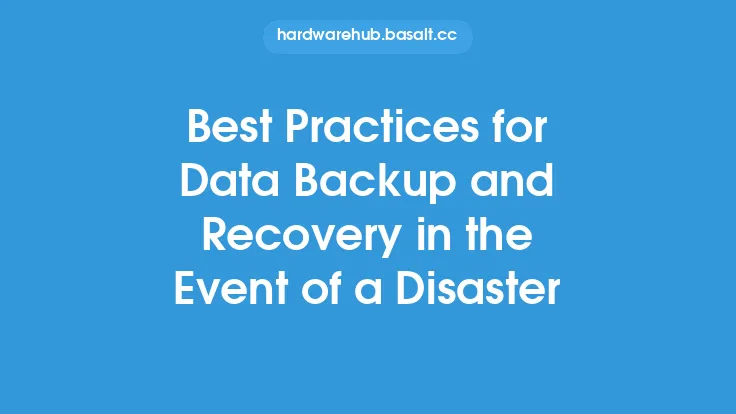In today's digital age, data has become a vital component of personal and professional life. The increasing reliance on digital information has made it essential to protect it from loss or corruption. Data loss can occur due to various reasons such as hardware failure, software corruption, human error, or natural disasters. This is where data backup and recovery come into play, serving as a safety net to prevent data loss and ensure business continuity.
Introduction to Data Backup
Data backup refers to the process of creating copies of data to prevent loss in case of a disaster or data corruption. It involves duplicating data from primary storage to secondary storage, which can be local, remote, or cloud-based. The primary goal of data backup is to ensure that data is recoverable in case of a disaster, hardware failure, or data corruption. There are various types of data backup, including full backup, incremental backup, differential backup, and synthetic backup. Each type has its own advantages and disadvantages, and the choice of backup type depends on the specific needs of the organization.
Data Recovery Process
Data recovery is the process of restoring data from backup storage to its original location or a new location. The data recovery process involves several steps, including assessing the damage, identifying the backup data, and restoring the data to its original location. The data recovery process can be complex and time-consuming, especially if the data is large or if the backup is not up-to-date. It is essential to have a well-planned data recovery process in place to minimize downtime and ensure business continuity.
Types of Data Backup Storage
There are various types of data backup storage, including local storage, remote storage, and cloud storage. Local storage refers to backup data stored on local devices such as hard drives, tape drives, or solid-state drives. Remote storage refers to backup data stored on remote devices such as network-attached storage (NAS) or storage area networks (SAN). Cloud storage refers to backup data stored on cloud-based services such as Amazon S3, Google Cloud Storage, or Microsoft Azure. Each type of storage has its own advantages and disadvantages, and the choice of storage depends on the specific needs of the organization.
Data Backup and Recovery Techniques
There are various data backup and recovery techniques, including disk imaging, file-level backup, and application-level backup. Disk imaging involves creating a complete image of a disk, including the operating system, applications, and data. File-level backup involves backing up individual files and folders. Application-level backup involves backing up specific applications and their associated data. Each technique has its own advantages and disadvantages, and the choice of technique depends on the specific needs of the organization.
Data Backup and Recovery Tools
There are various data backup and recovery tools available, including backup software, backup appliances, and cloud-based backup services. Backup software such as Veritas NetBackup, Commvault, and Veeam Backup & Replication provide a range of features and functionalities to manage data backup and recovery. Backup appliances such as Dell EMC Data Domain and HPE StoreOnce provide a dedicated platform for data backup and recovery. Cloud-based backup services such as Backblaze and CrashPlan provide a scalable and secure platform for data backup and recovery.
Best Practices for Data Backup and Recovery
There are several best practices for data backup and recovery, including the 3-2-1 rule, regular backup testing, and data backup rotation. The 3-2-1 rule involves having three copies of data, stored on two different types of media, with one copy stored offsite. Regular backup testing involves testing backup data to ensure it is recoverable. Data backup rotation involves rotating backup media to ensure that data is not stored on a single device. These best practices help ensure that data is properly backed up and recoverable in case of a disaster.
Common Challenges in Data Backup and Recovery
There are several common challenges in data backup and recovery, including data growth, backup window, and data security. Data growth refers to the increasing amount of data that needs to be backed up, which can make it challenging to manage backup storage and ensure data recoverability. Backup window refers to the time available for backup, which can be limited, making it challenging to complete backup jobs. Data security refers to the need to protect backup data from unauthorized access, which can be challenging, especially in cloud-based backup environments.
Future of Data Backup and Recovery
The future of data backup and recovery is expected to be shaped by emerging technologies such as artificial intelligence, machine learning, and cloud computing. Artificial intelligence and machine learning can help automate data backup and recovery processes, making them more efficient and effective. Cloud computing can provide a scalable and secure platform for data backup and recovery, making it easier to manage large amounts of data. As data continues to grow in importance, the need for effective data backup and recovery solutions will become even more critical, driving innovation and advancement in this field.
Conclusion
In conclusion, data backup and recovery play a critical role in preventing data loss and ensuring business continuity. With the increasing reliance on digital information, it is essential to have a well-planned data backup and recovery strategy in place. This involves understanding the different types of data backup, data recovery processes, and data backup storage options. It also involves choosing the right data backup and recovery tools and following best practices for data backup and recovery. As data continues to grow in importance, the need for effective data backup and recovery solutions will become even more critical, driving innovation and advancement in this field.





